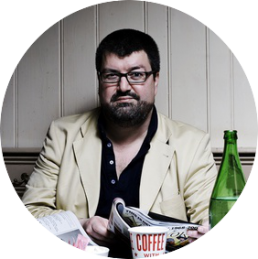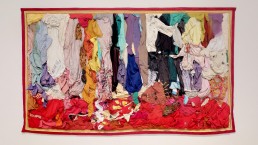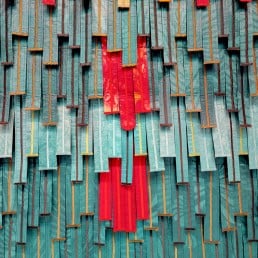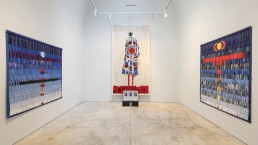Articles and Features:
Abdoulaye Konaté:
These Colors Don’t Run


Christian Viveros-Fauné | Kulchur Vulture
About: Viveros-Fauné is Artland’s inaugural Chief Critic and the contributor of this regular column. Based in New York City, he writes primarily about exhibitions and the cultural landscape there. His articles also often feature Artland’s revolutionary and market leading Artland 3D, virtual exhibition tours that enable the viewer to pay compelling virtual visits to actual exhibition spaces in support of the texts. This edition visits Blain Southern NY for the Abdoulaye Konaté exhibition, ‘Couleurs d’âme’.
If the major revelation that is Abdoulaye Konaté’s first U.S. solo show were a detective story, it’s motivation would be tucked away neatly, like a blood stained handkerchief hidden inside a desk drawer. Instead, his New York gallery, Blain Southern, has hung one of the artist’s most inspired textile works, L’Intolerance(1998), inside a small room at the end of what is a bombshell of an exhibition.

A riot of multi-colored ribbons made up of found t-shirts, skirts, scarves, jackets, flip-flops, and bullet casings covered in hand-scrawled text—spelling out the words “Algeria,” “Liberia” and “Kinshasa,” African locales that have seen their share of religious and political intolerance—the veteran artist’s found cloth painting is built atop a tattered figure splayed out horizontally on a pool of red cotton, polyester, rayon and taffeta. Like a wide-screen version of a street lynching, the effect is both mesmerizing and enveloping.
In a single picture, Konaté provides the viewer with both the elements of a crime and its possible motive—the textile trade and the volatile politics of underdevelopment—materials the artist adroitly folds into his artwork’s form and content. Also present at the scene, fourteen other large-scale tapestry-like works made with textiles produced or at least worn, in the case of L’Intolerance, in Mali, one of the world’s major producers of cotton fabric.


When Konaté was a young artist, between 1978 and 1985, he traveled to Havana, Cuba, to study and train directly with the Surrealist Wifredo Lam. Back in Bamako, with little access to paint and canvas, he made do with the materials most readily available to him. Thus was born a mostly abstract, color-rich picture making practice that consistently adopts figurative motifs and mosaic-like patterns into cinematically scaled, wall-mounted compositions.
Throughout a celebrated career, the sixty-six year-old artist’s unique way with stained cloth has delivered his monumental assemblages of cut and sewn streamers to major museums and biennales: among them, Sao Paulo, Dakar, Gwangju, Documenta and Havana, where his work is currently on view. The fact that New York audiences are just now seeing his pictures should clue the reader into the provincialism of our so-called center of the art world.

At Blain Southern’s inaugural Manhattan exhibition—the firsts come in pairs in this excellent show—Konaté arrays a selection of newer tapestries, with the odd historical piece thrown in for context. Among the latter are Lutte contre le HIV(1995), a Matisse-like patchwork depicting a woman dotted with blood-red fragments standing against a blank ground. At her feet, the artist places a chest with three depictions of the Mona Lisa—in the hopes, the artist has said, that the sick may receive some of the reverence art is routinely awarded.
More characteristic of the mostly abstract pictures the artist has made since the late 1990s are Vert Touareg au 3 cercles(2018) and La Croix(2019). If the first incorporates the iridescent blues and greens of Berber design, as well as a number of its symbols, the second features hundreds of Konaté’s hand-dyed ribbons in the shape of a fiery cross. Made by an avowed secularist, the picture celebrates color, symbol and pattern, along with an explicitly internationalist message: these colors don’t run.